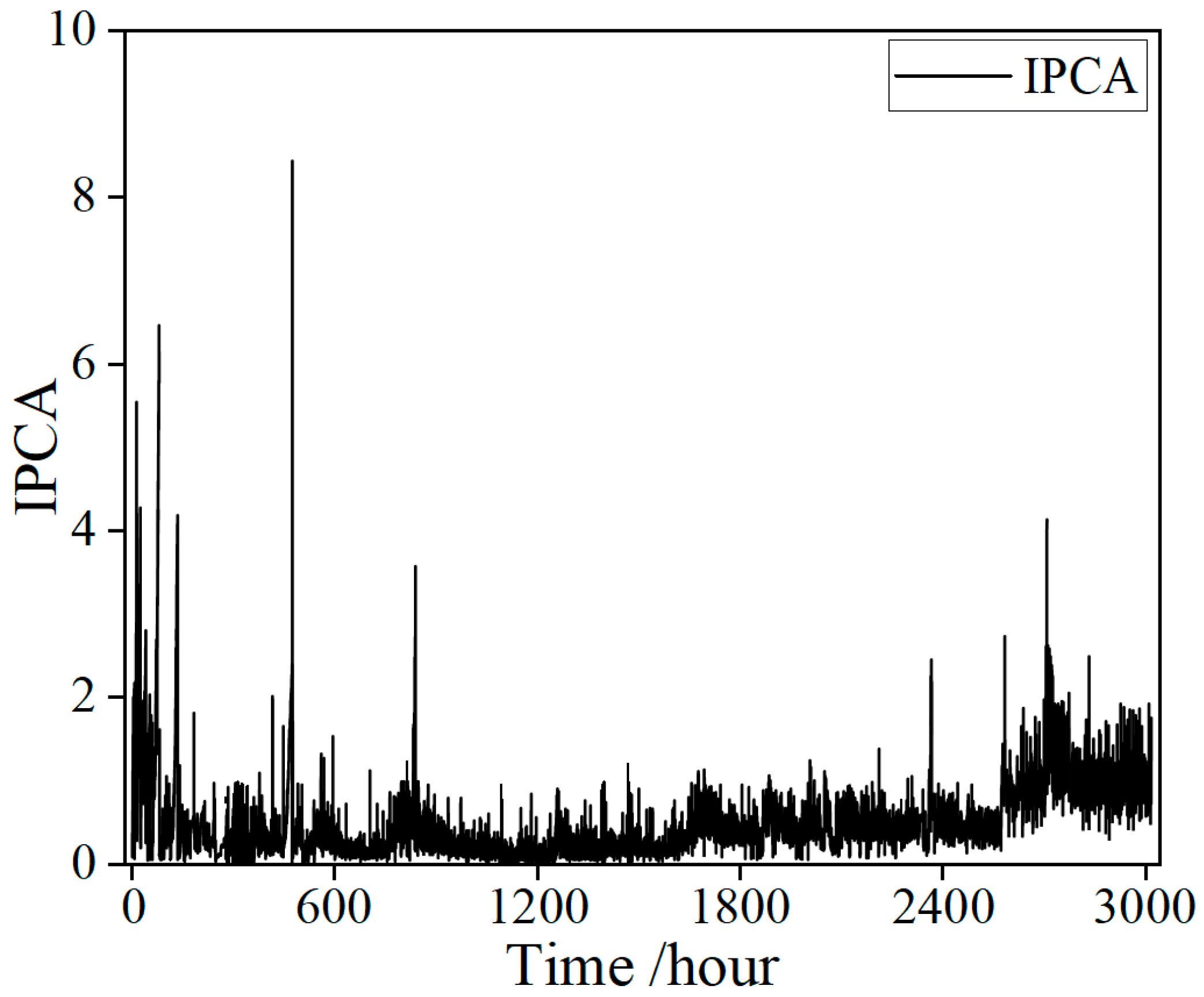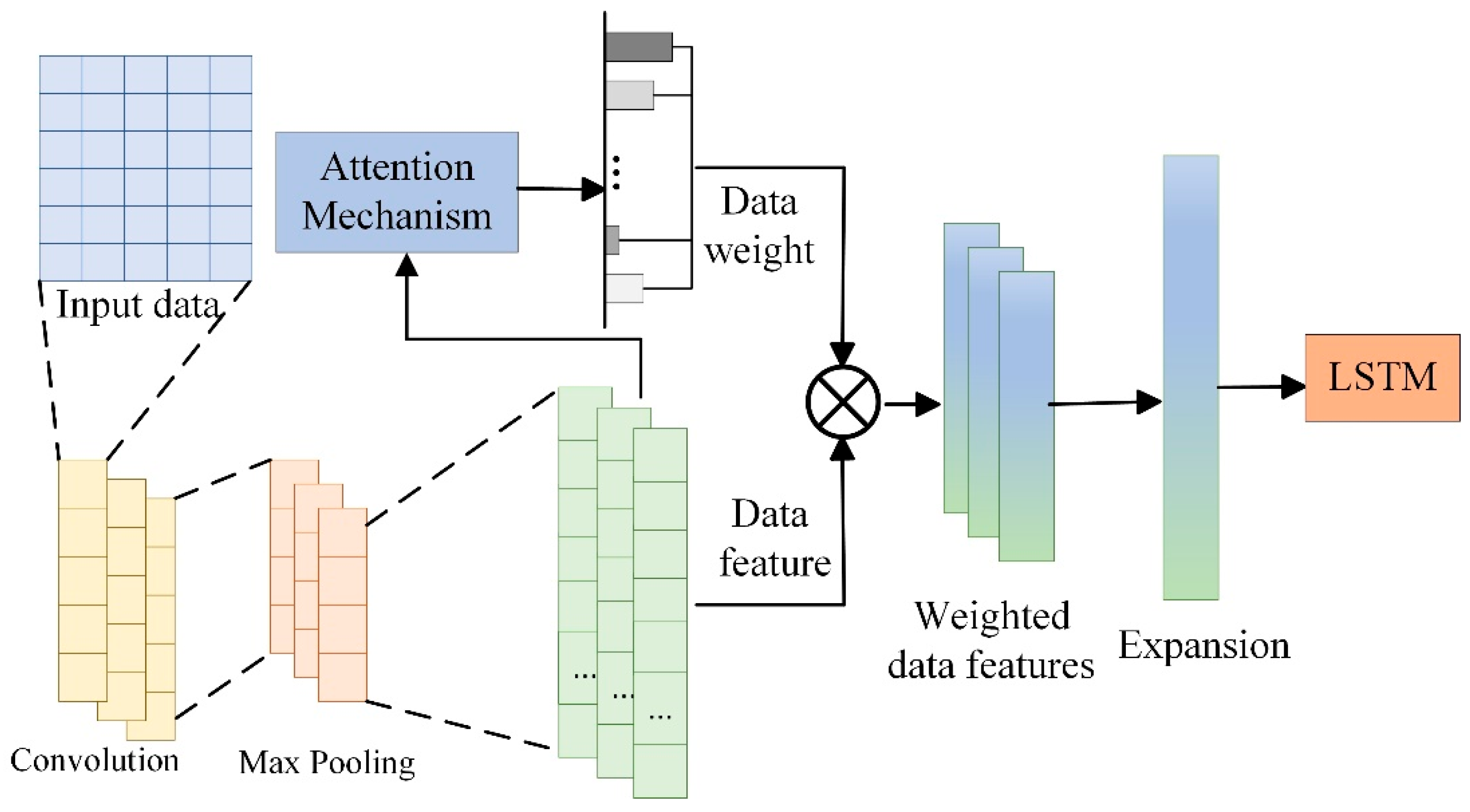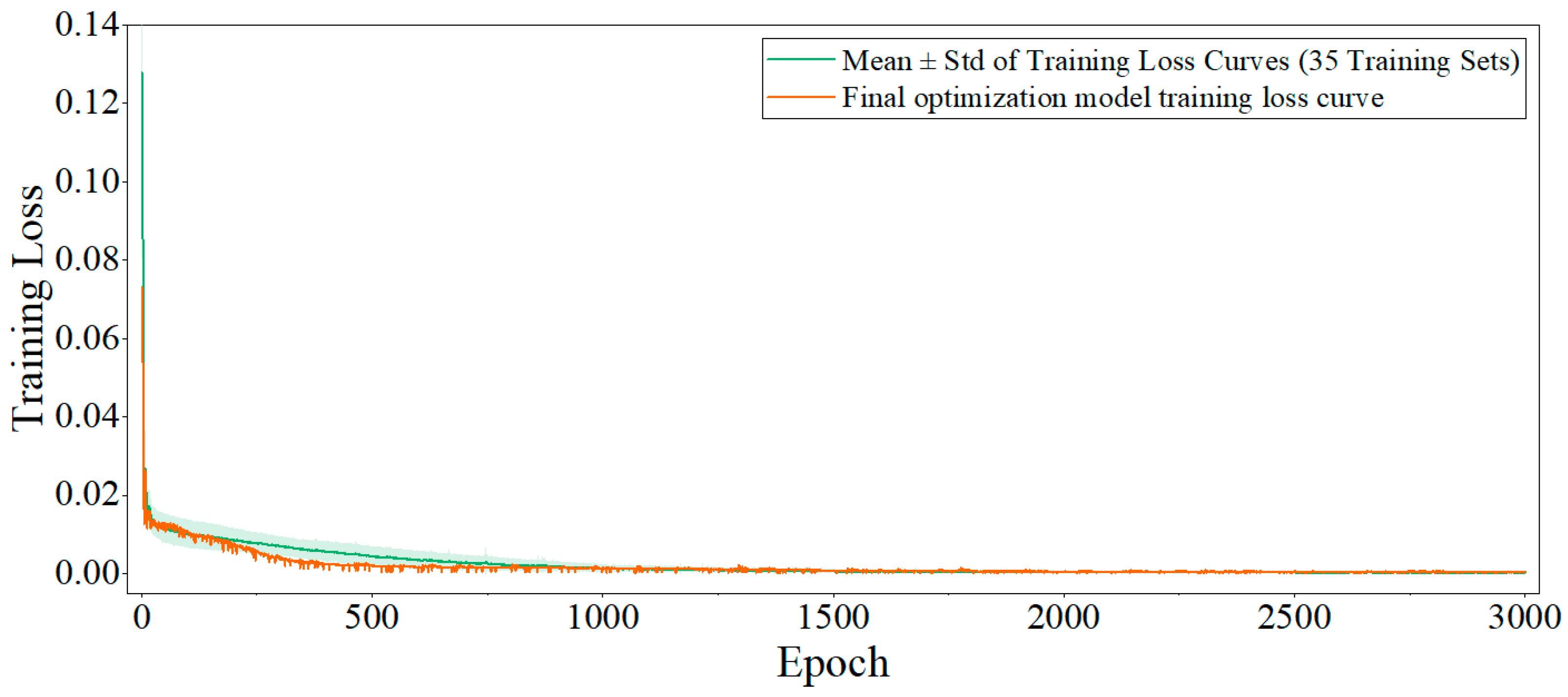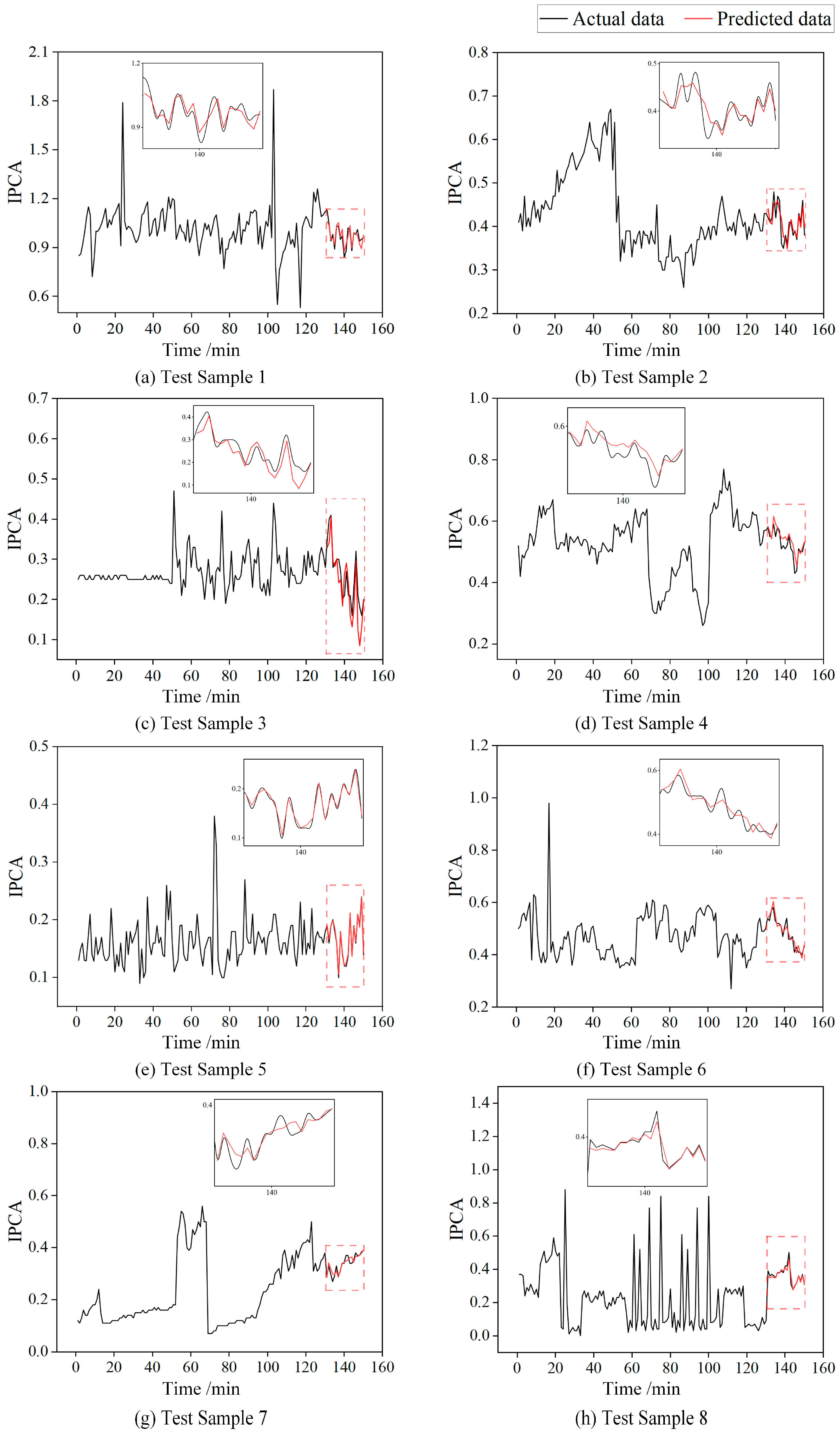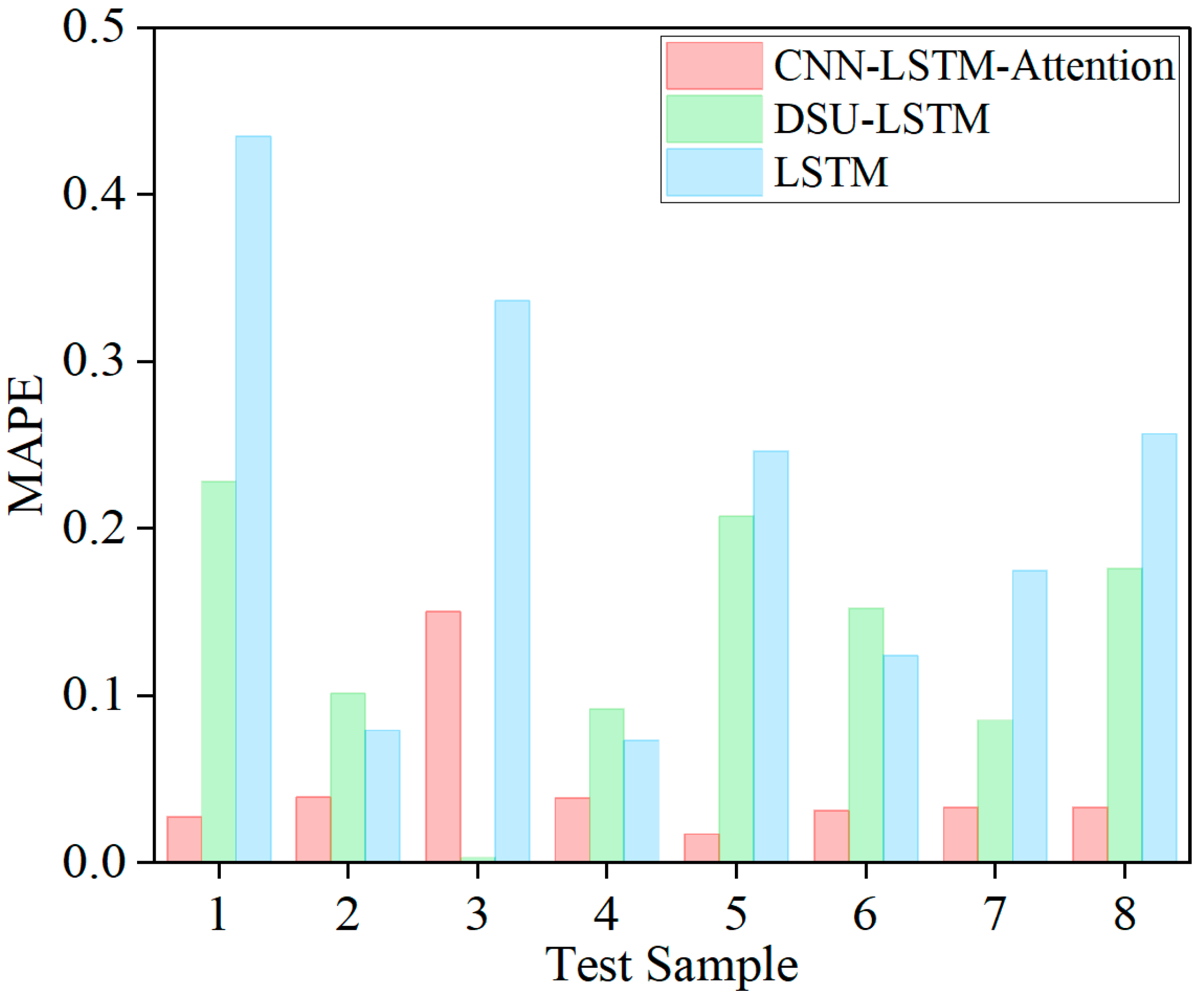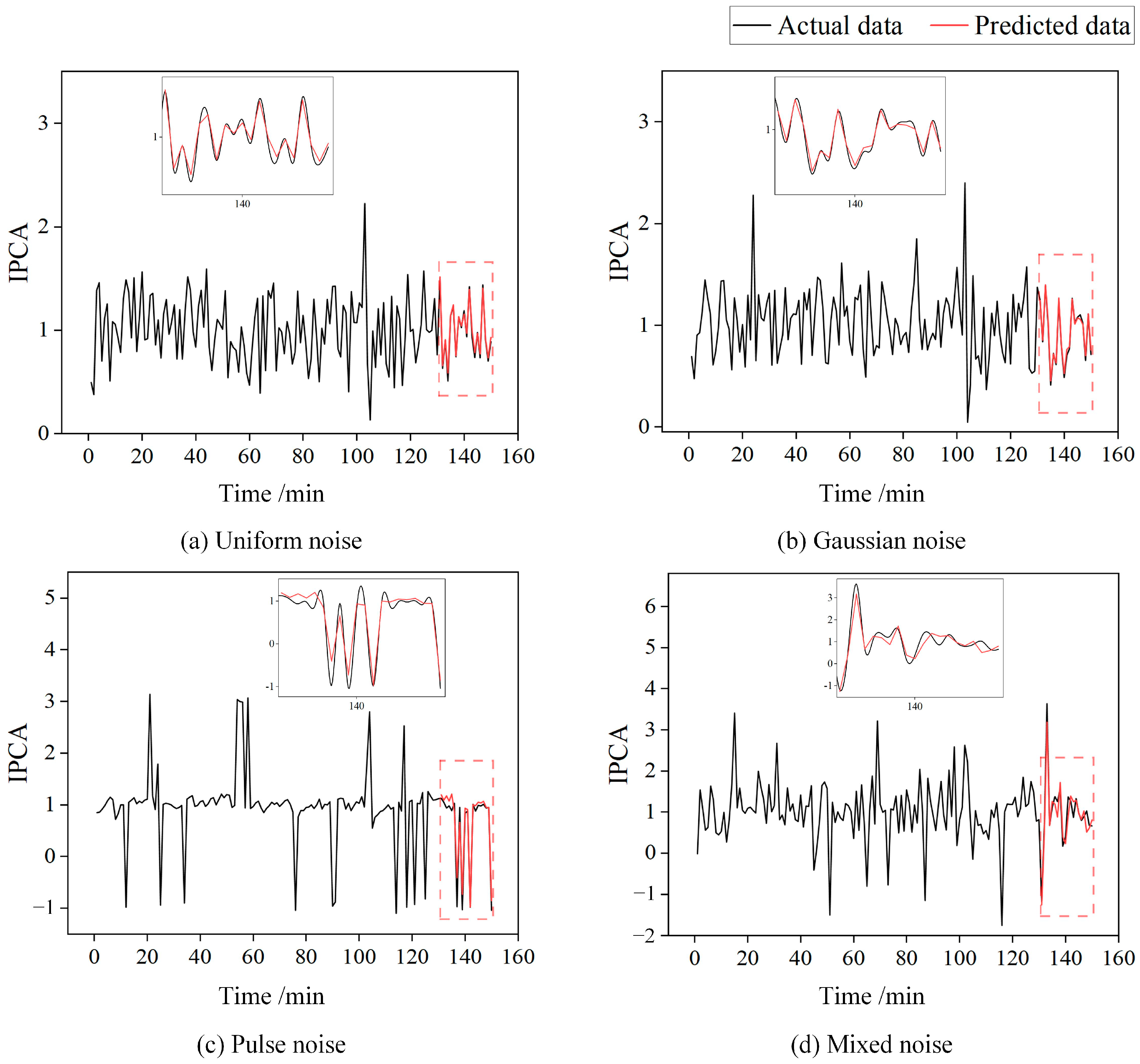1. Introduction
Lubricating oil, as a crucial friction-reducing material in mechanical equipment transmission systems, is pervasive in the friction components of equipment [
1]. It contains a wealth of tribological information about mechanical equipment [
2] and directly reflects the tribological characteristics and health level of equipment. By monitoring and analyzing lubricating oil data, the lubrication state of mechanical equipment can be obtained, whose health condition can be assessed in real time [
3,
4]. Therefore, oil monitoring technology is essential for the operation and maintenance of machinery [
5].
However, characterization data of lubricating oil performance is influenced by external operating conditions and internal physicochemical interactions, resulting in strongly nonlinear and dynamic time-varying characteristics. This complexity makes it difficult to extract key features effectively and poses challenges in feature extraction, temporal modeling, and wear state prediction. Therefore, the development of robust and accurate lubrication state prediction methodologies for mechanical systems presents considerable practical value.
Lubricating oil prediction technologies can be broadly classified into statistical methods and AI-based (artificial intelligence) methods. Statistical approaches establish correlations between lubricating oil monitoring data and equipment wear states by employing statistical models to analyze historical data, thereby predicting oil performance degradation and remaining useful life (RUL) [
6]. Common techniques include Kalman filtering, Markov processes, and Wiener process models (WPMs). For instance, Pan et al. [
7] proposed a mechanism-driven WPM framework that integrated lubricant monitoring data with degradation mechanisms to model nonlinear oil deterioration, enabling accurate RUL estimation. Similarly, Du et al. [
8] developed a hidden Markov model (HMM) to characterize the degradation evolution of lubricant conditions, deriving explicit formulations for the conditional reliability function (CRF) and mean remaining life (MRL) to facilitate RUL prediction. While these methods can achieve high accuracy when sufficient high-quality historical data and appropriate statistical models are available, their predictive capability is often limited when handling complex nonlinear relationships. In contrast, AI-based methods leverage data-driven pattern recognition to extract complex nonlinear relationships from historical data, offering enhanced prediction accuracy. These approaches demonstrate superior adaptability in modeling intricate and dynamic lubricant degradation behaviors [
9].
In recent years, significant research efforts have been devoted to oil monitoring-based prediction, yielding notable advancements. Liu et al. [
10] developed an information entropy–SVM (support vector machine) hybrid method for lubricant RUL prediction, where entropy-based feature selection from spectral data enhanced the efficiency and accuracy of SVM with high-dimensional inputs. Afrand et al. [
11] employed artificial neural networks (ANNs) to predict nano-lubricant viscosity, incorporating lubricant index correlations to improve model precision. Wang et al. [
12] introduced a CNN-based online monitoring system for wear particle images, automating the classification of wear debris and bubbles to boost feature extraction accuracy. An innovative 1D-CNN model for ball bearing wear prediction was proposed by Sun et al. [
13], which deciphered nonlinear relationships between oil spectral data and wear states. Su et al. [
14] integrated PCA, clustering, and LSTM to classify and predict wear states from online oil data, outperforming traditional statistical models. Li et al. [
15] proposed an LSTM–SVDD collaborative framework, where LSTM predicted oil parameter trends and SVDD constructed a hypersphere classifier for anomaly detection, enhancing online lubricant condition monitoring. Yin et al. [
16] combined 1D-CNN and LSTM to model friction coefficients of seawater-lubricated ceramic pairs, improving nonlinear time-series prediction accuracy. While CNNs excel at high-dimensional feature extraction and LSTMs capture long-term temporal dependencies, conventional CNN–LSTM architectures face limitations, such as the lack of adaptive feature weighting mechanisms, potentially overlooking critical time-variant features in oil data. This can lead to suboptimal importance allocation across temporal sequences, compromising prediction reliability.
In summary, significant research by numerous scholars has been conducted in the field of lubricating oil prediction, yielding promising results. However, for oil monitoring data with complex nonlinear features and dynamic trends, the prediction accuracy of commonly used models largely depends on the precise extraction of key features. Additionally, the dependency relationships and dynamic changes inherent in oil data often lead to deviations in prediction models, resulting in a bottleneck in the technology for predicting mechanical equipment wear state.
To address these issues, this paper proposes a CNN–LSTM–Attention temporal prediction model for predicting wear state evolution, guided by a feature self-attention mechanism and coupled with CNN’s high-dimensional feature extraction and LSTM’s long-term temporal feature modeling capabilities. This model achieves precise prediction of mechanical equipment wear state based on lubricating oil temporal evolution data. Firstly, high-dimensional features are automatically extracted from lubricating oil monitoring data using the CNN model, ensuring effective capture of nonlinear features during oil changes. Secondly, the attention mechanism is introduced to amplify the impact of key features while suppressing interference from non-essential features, addressing the issue of traditional models failing to fully distinguish the importance of temporal features. Finally, the LSTM model is combined to explore the temporal dependencies in lubricating oil monitoring data, further improving prediction accuracy. This model can deeply extract local features from lubricating oil monitoring data while dynamically adjusting feature weights according to their importance, thereby enhancing the representation of key features and capturing long-term dependencies in the data.
The remainder of this paper is organized as follows.
Section 2 details the establishment of an online lubricating oil monitoring system for acquiring historical lubricant data and introduces the principles and specific implementation steps of the CNN–LSTM–Attention model.
Section 3 presents the validation results of the proposed approach.
Section 4 discusses the results in depth, and
Section 5 summarizes the main conclusions. Additionally, the
Appendix A,
Appendix B and
Appendix C provides an overview of the basic concepts of CNNs, the attention mechanisms, and LSTM.
2. Materials and Methods
2.1. Experiment Setup
Lubricating oil monitoring technology is a sensor-based analytical technique that provides deep insights into the wear characteristics of lubricating oil [
17]. Wear debris present in lubricating oil constitutes both a product of wear and an initiator of further wear [
18]. Hence, as the most direct and essential carrier of information for investigating wear behavior, wear debris concentration serves as a critical and readily observable parameter for characterizing the wear state of equipment. In the present study, an online lubricating oil monitoring system was developed, the schematic representation of which is illustrated in
Figure 1.
The system consists of an online lubricating oil monitoring sensor, a friction pair, an oil circulation system, and a data transmission system. For the online lubricating oil monitoring sensor, the Online Visual Ferrograph (OLVF) sensor [
19] was selected. This sensor can capture wear particle images under three distinct light conditions: transmitted light, reflected light, and full-spectrum illumination. This multi-source imaging approach effectively minimizes false particle detection by cross-validating morphological features. Featuring sub-5-micron optical resolution, the system provides high-definition characterization of particle morphology, surface texture, and edge definition. Its optimized detection range spans 20 to 200 microns, covering critical wear particle sizes indicative of mechanical component degradation in industrial systems.
The OLVF operates on the principle of magnetic deposition and image analysis. It incorporates electromagnetic components positioned within the lubricant flow path to deposit wear particles. Images of the deposited wear particles under controlled illumination are subsequently acquired. Quantitative assessment of wear debris is achieved by calculating the relative Index of Particle Coverage Area (IPCA), as expressed by the following formula:
where
is the number of object pixels of wear debris in the segmented image,
is the width of the ferrograph image, and
is the height of the ferrograph image.
The system operates as follows:
- (1)
Oil Extraction: Lubricating oil is extracted from a gearbox containing bearings.
- (2)
Cooling: The extracted oil is passed through a cooling device to reduce its temperature.
- (3)
Monitoring: The cooled oil is then transported to the OLVF sensor, where IPCA data are detected.
- (4)
Recirculation: After monitoring, the oil returns to the gearbox through the oil circulation system and undergoes filtration before entering the gearbox oil pool.
To ensure accurate monitoring, the system includes a cooling device to mitigate the effects of heat generated during high-speed operation of the gearbox. The physical setup of the monitoring system is shown in
Figure 2.
In this study, a 3000 h full-lifetime test was designed, during which the ferrograph sensor continuously monitored wear particle information in the lubricating oil. To closely simulate the actual operating scenarios of aero-engines, the experiment was divided into eight different operating conditions, which were cycled according to their respective durations as shown in
Table 1. These conditions encompass a range of rotational speeds (9004 to 13,741 rpm) and operational durations (approximately 10 to 54 min per cycle), reflecting the variability commonly encountered in industrial and aerospace applications.
The selection of these specific rotational speeds and durations was based on two main considerations. First, the tested speeds cover both medium- and high-speed regimes typical of main gearbox or accessory drive shafts in modern aero-engines, where operational speeds often range from around 9000 rpm up to over 13,000 rpm. Second, the alternating duration of each speed segment reflects real-world engine operating patterns, including continuous cruise, transient acceleration/deceleration, and other mission profiles. By cycling through these variable conditions, the experiment aims to ensure that the collected data adequately represent the dynamic and complex loading environments experienced in service, thereby enhancing the reliability and applicability of the monitoring and prediction results for practical engineering use.
As shown in
Table 1, the experiment covers a wide range of rotational speeds, from 9004 rpm to 13,741 rpm, and varying operating durations. Conditions 1 and 8, 2 and 7, and 3 and 6 have identical rotational speeds and durations, ensuring consistency in the experimental design.
During the experiment, a large volume of oil monitoring data were collected, primarily recording the IPCA under different operating conditions. Exemplar raw signals collected from the sensor are shown in
Figure 3. The IPCA exhibits distinct stage-dependent fluctuations over the 3000 h monitoring period. During the initial 100 h, the IPCA values fluctuate sharply, with multiple pronounced spikes, indicating frequent occurrences of abnormal particle generation in the early stage of the lubrication system. Subsequently, from 100 to 2600 h, the overall IPCA level decreases markedly and remains relatively stable within a lower range, suggesting that the wear state of the equipment tends to stabilize. In the later phase of the experiment, after approximately 2600 h, the IPCA rises again significantly, accompanied by several new spikes, indicating intensified wear or the emergence of new abnormal events. Overall, the IPCA curve shows pronounced volatility and sudden peaks during both the early and late stages, while remaining relatively stable in the middle phase. This trend reflects the evolution of wear throughout different life-cycle stages of the equipment.
To improve data utilization and modeling efficiency, the original full-condition dataset was divided into eight subsets, each corresponding to a specific operating condition. Taking Condition 1 as an example, a segment of IPCA time-series data with a length of 150 was randomly selected from its interval as a model input sample for predicting the trend of wear particle concentration. This partitioning and sampling approach ensures comprehensive coverage of different conditions and enhances both sample diversity and training efficiency.
Figure 4 shows the typical oil data history for Condition 1.
2.2. Problem Statement
As shown in
Figure 4, from the overall trend, it can be seen that the motor starts at 20 min. In the initial stage (20–60 min), the lubricating oil shows characteristics of rapid increase followed by a sharp decline: the IPCA rises to 0.8 and then drops to 0.1. At the moment of equipment startup, the gear pair is subjected to a large torque, resulting in an instantaneous increase in IPCA. Additionally, the drastic change in IPCA during this stage is related to the gradual smoothing of asperities on the friction pair surface during the running-in process of the gear system. Subsequently, the data enter a stable period (60–150 min), where the wear state of the lubricating oil stabilizes, conforming to the time-evolution law of “initial adjustment–middle steady state”.
However, the abrasive particle concentration is influenced by factors such as lubricating oil properties, contaminants, wear particles, and wear surface roughness. Meanwhile, wear, filtration, and sedimentation effects can also introduce significant uncertainties into the monitoring data of particle concentration. Under the combined influence of external operating conditions and internal physicochemical interactions, the instantaneous changes in lubricating oil wear performance characterization data exhibit strong nonlinearity and dynamic time-varying characteristics. In practical engineering applications, the inherent complexity of lubricating oil monitoring datasets poses significant challenges for effective feature extraction and trend prediction.
Currently, the accuracy of commonly used lubricating oil wear state prediction models is primarily constrained by three technical bottlenecks. Firstly, when dealing with oil monitoring datasets with complex tribological characteristics, the accuracy of model feature selection and extraction directly affects the quality of prediction results. Secondly, after feature extraction, the ability to accurately identify key features influencing data changes from numerous features significantly impacts prediction accuracy. Finally, given the strong dynamic time-varying characteristics in oil monitoring data, accurately capturing the temporal dependencies in the data is crucial to ensuring prediction accuracy. These problems demonstrate insufficient capability in capturing dynamic relationships between lubricant performance degradation and wear progression mechanisms. When extrapolating to evolving operational conditions over extended durations, due to inadequate consideration of the nonlinear characteristics inherent to tribological systems, traditional methods also exhibit constrained generalization capabilities. Furthermore, the linear assumptions, computational complexity, and parameter selection limitations of these methods further constrain the accuracy of lubricating oil wear state prediction [
20].
2.3. CNN–LSTM–Attention
To address the challenges of feature extraction and trend prediction in lubricating oil monitoring data, this study develops a more accurate CNN–LSTM–Attention model. Throughout the service life of lubricating oil, variations in particle concentration are governed by the combined effects of mechanical wear mechanisms and environmental disturbances, resulting in pronounced non-stationarity in the monitoring data. This multifactorial coupling greatly increases the complexity of extracting meaningful features from lubricant monitoring signals. CNNs (whose fundamental principles are outlined in
Appendix A and described in detail in [
21,
22]) demonstrate notable advantages in feature extraction and are highly effective at capturing intricate local patterns. However, conventional pooling layers with coarse downsampling may lead to the loss of essential degradation features, such as the IPCA. The attention mechanism (see
Appendix B and references [
23,
24]) dynamically assigns weights and adaptively focuses on high-information-entropy regions, thus effectively mitigating the core challenges of “feature dilution” and “noise interference” in lubricant monitoring.
Moreover, lubricant monitoring data are inherently strongly time-dependent and non-stationary, with degradation trajectories frequently exhibiting long-term dependencies, such as the autocorrelation decay of particle concentration. Compared with traditional machine learning models, which often suffer from issues like gradient vanishing and memory truncation when handling time-series data, LSTM (see
Appendix C and references [
25,
26]) networks can adaptively capture multi-scale degradation trends in lubricant monitoring data, thereby providing robust support for temporal causal inference in lubricant condition evolution.
By combining the local feature extraction capability of CNNs with an attention mechanism, the flexibility and accuracy of extracting temporal data features are further improved, enabling CNNs to adaptively focus on key features in lubricating oil data. Subsequently, the LSTM model captures the time-series dependency in lubricating oil monitoring data, further enhancing prediction accuracy. A schematic diagram of the proposed method is shown in
Figure 5.
As shown in
Figure 5, this method realizes hierarchical feature processing of lubricating oil monitoring data through a three-stage cascaded structure of CNN–LSTM–Attention. Specifically, the CNN convolutional layer extracts spatial features of the monitoring data [
27], such as the local variation patterns of IPCA (Particle Coverage Area Index). The pooling layer incorporates an attention mechanism, which can automatically identify key feature regions. The LSTM network captures the correlation in time series to understand the cumulative trend of lubricating oil wear. The attention mechanism performs secondary weighting to highlight the contribution degree of important feature channels: through learnable weight matrices (such as Query–Key matrices), it achieves adaptive allocation of feature importance. Combined with the long-term storage units of LSTM, this effectively solves the challenge of temporal dependency in time-series data and improves the accuracy and reliability of lubricating oil wear state prediction. The integration of these three methods enables the proposed model to exhibit stronger representation capability and excellent performance in lubricating oil data prediction tasks.
The proposed model employs a comprehensive feature extraction and temporal modeling pipeline to process oil monitoring data. First, two convolutional layers are defined, and each convolutional layer uses the ReLU activation function to extract the local features of lubricating oil monitoring data to enhance the nonlinear representation capability. The convolution calculation formula is as follows:
where
represents the input function,
represents the convolution kernel, and
represents the output function. In continuous form, the convolution operation can be understood as sliding the convolution kernel over the input function and calculating the result of the convolution operation at each position.
Both convolutional layers utilize [3, 1]-shaped convolution kernels that slide across the input data with a stride of 1 to extract local features, each generating 32 feature maps (totaling 64). The convolution process computes element-wise products between the kernel and input regions, summing them to form feature maps. Subsequently, global average pooling is applied along the spatial dimensions of each feature map, producing an output vector of a length equal to the number of channels. For an input feature map of size [
,
,
], the pooling operation is defined as
where
represents the pixel value of the c-th channel at position
, while
denotes the output value of that channel after pooling. The output vector of the pooling layer has a dimension of [1,1,
].
Following the pooling layer, an attention mechanism module is introduced, which consists of two key steps: Squeeze and Excitation. The Squeeze step, consistent with the pooling operation, compresses the spatial dimensions (height and width ) into a single channel descriptor. This is already accomplished by the pooling layer, resulting in a feature vector of size [1,1,]. The Excitation step learns inter-channel dependencies through fully connected layers to generate a weight for each channel. Finally, the weight vector generated by the SE attention mechanism is multiplied element-wise with the original feature map to recalibrate the importance of each channel. This channel-wise weighting strategy adaptively enhances features critical to the task.
The key features processed by the attention mechanism are fed into an LSTM network, which includes
- (1)
A sequence unfolding layer that reorganizes the data for subsequent processing.
- (2)
A flatten layer that converts multi-dimensional data into a one-dimensional vector for input to the fully connected layer.
- (3)
A LSTM layer with 6 units, configured to output only the result of the last time step via the “last” output mode.
- (4)
A fully connected layer with an output dimension of 1 to process the output from the LSTM layer.
- (5)
A regression layer that outputs the final prediction of the lubricant wear state.
The LSTM captures the temporal dynamics in the oil monitoring time-series data, and regression is performed to forecast future values, thereby enabling the prediction of the lubricant wear state.
5. Conclusions
This study presents a novel CNN–LSTM–Attention hybrid model for high-precision prediction of wear state in lubricating oil monitoring systems. The key innovations are as follows:
Advanced Feature Extraction: The CNN module, through hierarchical convolutional layers, effectively captures high-dimensional spatial and temporal features from oil monitoring data, automatically learning complex nonlinear degradation patterns and reducing reliance on manual feature engineering.
Dynamic Feature Importance Weighting: The introduction of a self-attention mechanism enables the model to adaptively identify and focus on diagnostically critical features while effectively suppressing irrelevant noise. This greatly enhances the model’s interpretability and predictive reliability under variable operating conditions.
Long-Term Temporal Dependency Modeling: The LSTM component effectively models long-term dependencies in monitoring data, accurately tracking the temporal evolution of wear processes and addressing the limitations of conventional approaches in long-term degradation prediction.
In practical tests across eight samples, the proposed model demonstrated excellent and stable predictive performance. Specifically, it achieved a low MAPE of 0.046, which is significantly better than the comparison models DSU–LSTM (0.131) and LSTM (0.216). These results indicate that the method offers not only high accuracy, but also strong adaptability and generalization capability.
In summary, the CNN–LSTM–Attention model provides a robust technical foundation for the predictive maintenance of industrial equipment. It also shows great potential for applications in other fluid condition monitoring and degradation trend prediction tasks, supporting intelligent operation and health management in complex engineering scenarios.






